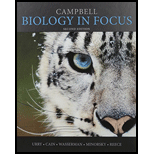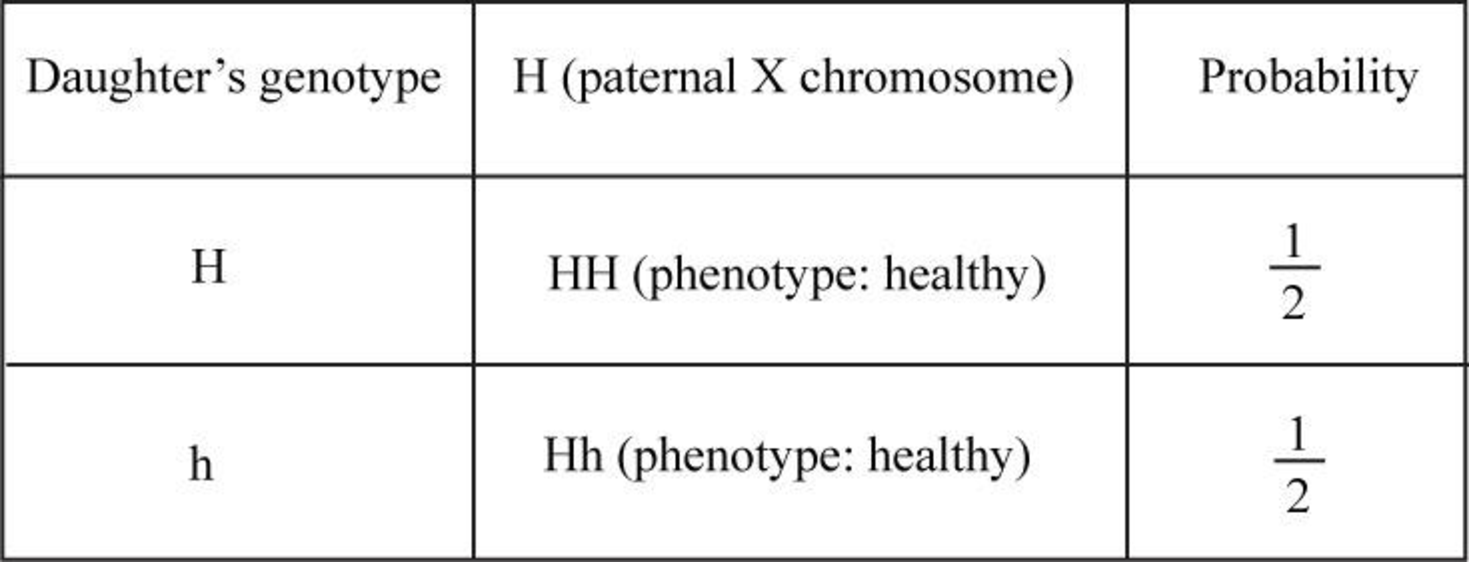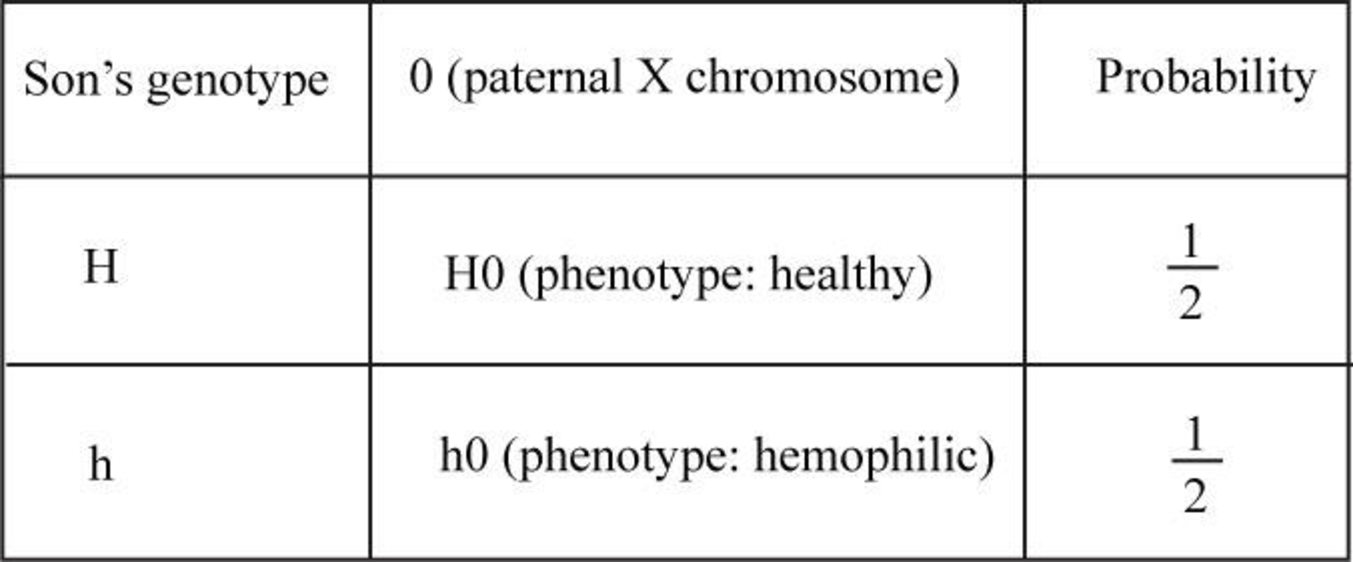
Concept explainers
A man with hemophilia (a recessive, sex-linked condition) has a daughter without the condition, who marries a man who does not have hemophilia. What is the probability that their daughter will have the condition? Their son? If they have four sons, that all will be affected?
To determine:
The probability that son will have the hemophilia condition, when a man with hemophilia (a recessive, sex-linked condition) has a daughter without hemophilia who marries a man who does not have hemophilia. Determine whether all the four sons will be affected or not.
Introduction:
Hemophilia is a sex-linked disorder, which impairs the blood-clotting mechanism in the affected individuals. Those individuals who receive the non-functional gene from their parents must have X-chromosome linked to recessive trait.
Explanation of Solution
Consider the genotypes of daughter as H and h. As the male suffers from the hemophilic condition, the disorder is linked with the male chromosomes XY. The disorder is recessive and sex-linked. Here, the male chromosomes are considered as Hh. The probability that the daughter will be hemophilic is zero.

The female has one wild type allele (H) and one recessive mutant allele (h). The male has only wild-type allele and a Y chromosome. If the disorder is not linked with Y chromosome, then it is considered to be 0. The males received only one X chromosome, and hence, they have higher chances of carrying this disorder.

The sons have 50% chances of being affected by hemophilia. There is ½ probability that the sons are affected by the hemophilic condition.
Here, the Y chromosome does not contain hemophilia. Therefore, the hemophilic conditions are more dominant in sons.
As each son has a 50% chance of being affected by hemophilia, the probability of four sons is calculated as follows:
Here, the probability of all the sons who are affected is
The man with hemophilia and his daughter and son in law without this disease and the probability of acquiring this disease in his granddaughter is about 0. If he has a grandson, then it would be of ½ probability and in case if he has 4 grandsons, then it would be of 1/16 probability.
Want to see more full solutions like this?
Chapter 12 Solutions
Campbell Biology in Focus; Modified Mastering Biology with Pearson eText -- ValuePack Access Card -- for Campbell Biology in Focus (2nd Edition)
Additional Science Textbook Solutions
Biological Science (6th Edition)
Biology: Life on Earth with Physiology (11th Edition)
Chemistry: A Molecular Approach (4th Edition)
Physics of Everyday Phenomena
HUMAN ANATOMY
Campbell Essential Biology (7th Edition)
- explain the cascade of events (starting with relaxing trade winds) that occurs during El Niño in the eastern Pacific (off the coasts of California/North America and Peru/South America) and which lead to food-chain collapse - start with changes in the physical/oceanographic conditions, andthen systematically describe the cascading effects at each level of the food chain -arrow_forward3) Which statement(s) about the Pacific Decadal Oscillation (PDO) is/are TRUE? CIRCLE ALL THAT APPLY. A. It is a major driver of salmon populations in the Pacific B. It affects sea surface temperatures in the eastern Pacific C. Its cycles typically do not last as long as those of ENSO D. Evidence that it has occurred over many centuries has been gathered from tree ring dataarrow_forward4.arrow_forward
- 2arrow_forward1. 2. 3. Marine fish cells are hypotonic compared to their seawater environment; their cells lose water by osmosis and gain solutes. If you add heterotrophic respiration and autotrophic respiration together and then subtract that value from gross primary productivity, then you have a more refined estimate of ecosystem carbon storage than NEE. Differential heating due to the earth's tilt generates the global wind AND oceanic circulation patternsarrow_forward1arrow_forward
- 4arrow_forwardDoes it show the level of proteins? What about the amount? Levels of protein activation? How can you tell? Does the thickness tell you anything? What about the number of the lines? And the other questionsarrow_forwardKD 200- 116- 66- Vec ATF6 (670) ATF6 (402) ATF6 (373) ATF6 (366) I I 45- 1 2 3 4 5 ATFG (360) (e/c) 9V ATFG (402) g ant- ATF anti-KDEL DAPI barrow_forward
 Human Biology (MindTap Course List)BiologyISBN:9781305112100Author:Cecie Starr, Beverly McMillanPublisher:Cengage Learning
Human Biology (MindTap Course List)BiologyISBN:9781305112100Author:Cecie Starr, Beverly McMillanPublisher:Cengage Learning Human Heredity: Principles and Issues (MindTap Co...BiologyISBN:9781305251052Author:Michael CummingsPublisher:Cengage Learning
Human Heredity: Principles and Issues (MindTap Co...BiologyISBN:9781305251052Author:Michael CummingsPublisher:Cengage Learning
 Concepts of BiologyBiologyISBN:9781938168116Author:Samantha Fowler, Rebecca Roush, James WisePublisher:OpenStax College
Concepts of BiologyBiologyISBN:9781938168116Author:Samantha Fowler, Rebecca Roush, James WisePublisher:OpenStax College Biology (MindTap Course List)BiologyISBN:9781337392938Author:Eldra Solomon, Charles Martin, Diana W. Martin, Linda R. BergPublisher:Cengage Learning
Biology (MindTap Course List)BiologyISBN:9781337392938Author:Eldra Solomon, Charles Martin, Diana W. Martin, Linda R. BergPublisher:Cengage Learning Biology Today and Tomorrow without Physiology (Mi...BiologyISBN:9781305117396Author:Cecie Starr, Christine Evers, Lisa StarrPublisher:Cengage Learning
Biology Today and Tomorrow without Physiology (Mi...BiologyISBN:9781305117396Author:Cecie Starr, Christine Evers, Lisa StarrPublisher:Cengage Learning





